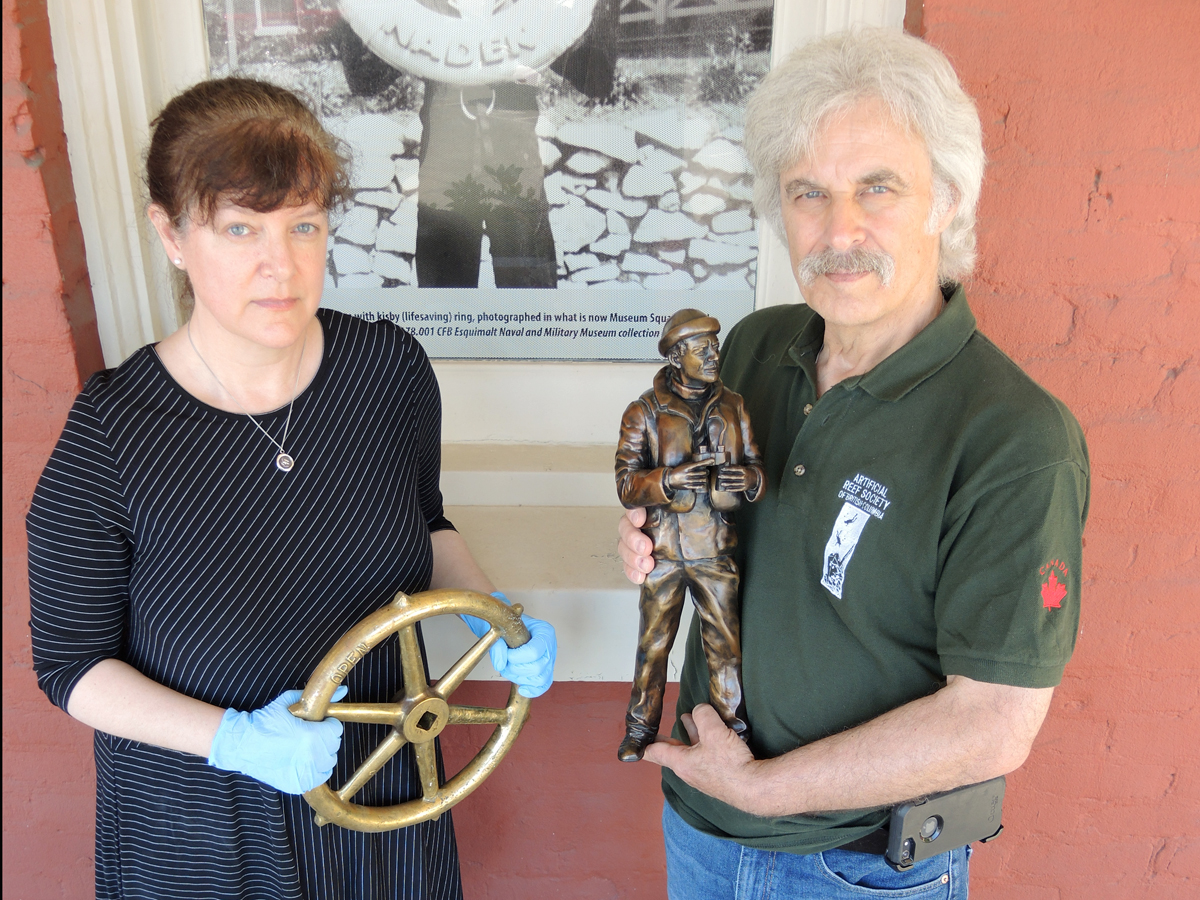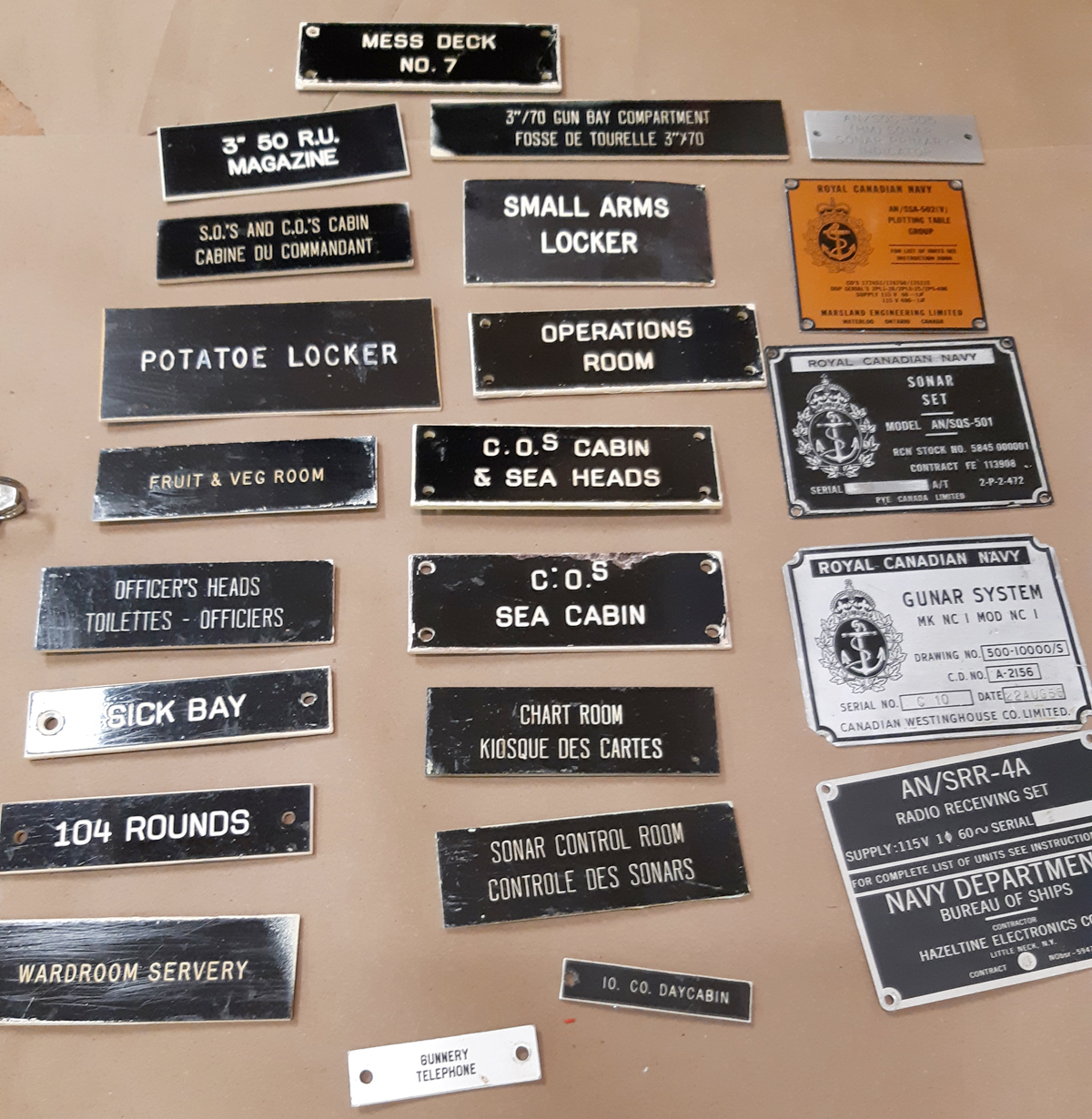Esquimalt Naval and Military Museum receives new items
By Lookout Production on Aug 06, 2022 with Comments 0

Tatiana Robinson, Curator of the CFB Esquimalt Naval and Military Museum, displays a solid brass wheel from HMCS Columbia. Howard Robins, President of the Artificial Reef Society of British Columbia, displays a sculptor’s maquette of a Second World War-era merchant mariner that was to be placed on the flight deck of HMCS Cape Breton. They were some of the many items presented by the ARSBC to the museum in a presentation made on July 25 in Esquimalt.
Peter Mallett,
Lookout staff writer
—
A collection of naval artifacts from five former Royal Canadian Navy (RCN) warships made its way to the CFB Esquimalt Naval and Military Museum.
The artifacts were delivered and presented to museum staff on July 25 by Howard Robins, President of the Artificial Reef Society of British Columbia (ARSBC).
“Everything I brought with me to the museum was either one or two of a kind on a ship we were working,” Robins said. “I looked for things that were memorable or personalized, or can in some way relate to the ship as a souvenir.”
The items range from a brass statue to firing triggers, alarm bells, and ammunition magazine clips.
Robins’ non-profit foundation was formed over 30 years ago and has sunk six former HMCS vessels to form nine of its artificial reefs in the coastal waters of B.C.
The ARSBC was displaying the items at trade shows or using them for educational purposes for students and other dive community members but deemed they were no longer needed.
New partnership
CFB Esquimalt Naval and Military Museum curator Tatiana Robinson said she was excited to receive the delivery. She also confirmed it was the first time the museum and the ARSBC had worked together.
“We are delighted to receive these materials and to be working with the Artificial Reef Society of British Columbia in our first partnership,” Robinson said. “We are so happy to receive these naval artifacts and become their custodians for future generations to enjoy.”
Now Robinson and her staff will determine which items will be incorporated into museum exhibits and which will be put into storage. Robinson says only five to ten per cent of donated items will make it into displays immediately.
Robins says his organization is currently working on a project that will see a life-sized model of a Sea King helicopter placed on the flight deck of Annapolis, the last RCN ship they sunk as an artificial reef, as a part of a strategic effort to enhance sea life and biodiversity.
Art and Artifacts
A maquette of a Second World War-era Merchant Marine. Salt Spring Island sculptor Simon Morris made the model.
- It was expected to lead the way to a much more giant brass statue on the flight deck of the Second World War Victory-Class ship, the former HMCS Cape Breton (FMG 100). The ARSBC sunk Cape Breton in 2001 off Snake Island near Nanaimo.
- Morris was going to pay tribute to the legacy of merchant marines but the ARSBC ran into financing difficulty, according to Robins, and the project was scuttled. The maquette was the only remaining souvenir of the project.
A solid brass wheel from the engine room of Restigouche-class destroyer escort, the former HMCS Columbia (DDE 260) sunk in 2006 near Campbell River. It served the RCN during the Cold War.
Items from Restigouche-class destroyer escort, the former HMCS Chaudière (DDE 235), the first warship the ARSBC sunk near Sechelt. The items include a framed image of the Chaudière, a forward turret firing trigger from the ship’s 3” 50 cannon, and a diesel tank oil cover.
A collection of ammunition clips of solid brass from the Annapolis class destroyer, the former HMCS Annapolis (DDH 265). The second ship named DDH 265 served the RCN from 1964 to 1996 and became a reef near Gambier Island in 2015. Robins included the ship’s failure alarm bell located in the ship’s steering compartment.
A collection of signage and name tags from the former HMCS Yukon (DDE 263) was sunk off San Diego in 2000 by the San Diego Reef Foundation, with assistance from the ARSBC. Some signage includes the ship’s wheelhouse, small arms locker, Sick Bay, and Operations room, along with a misspelled sign from the ship’s ‘Potatoe’ Locker.
For more information about the ARSBC and its reef projects, visit
www.artificialreefsocietybc.ca
For more information about the CFB Esquimalt Naval and Military Museum, visit navalandmilitarymuseum.org
Filed Under: Top Stories
About the Author:






